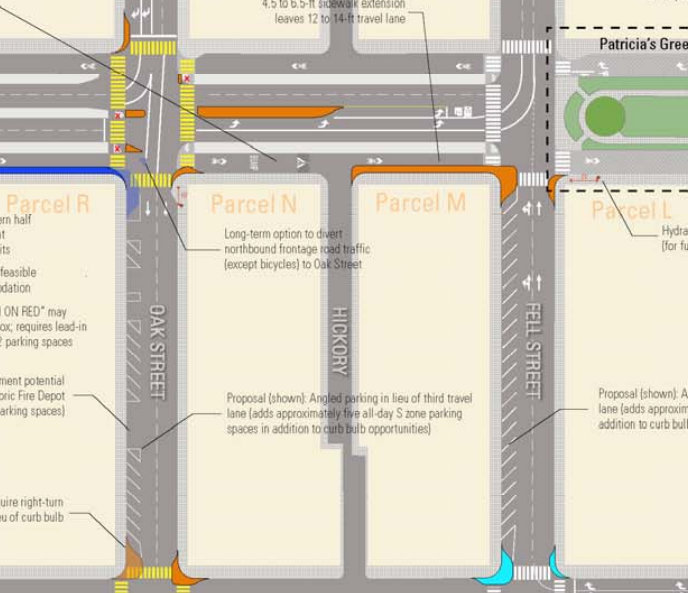
Ten years after Octavia Boulevard opened in the footprint of the former Central Freeway, the SFMTA has proposed a package of short-term safety fixes for people walking and biking, especially along the cross streets.
The upgrades could be implemented by the end of 2016. Proposals in the works include a bike lane on eastbound Page Street, a fix for the poorly-designed bike "chute" at Octavia and Market Street, "shared street" treatments in the frontage lanes on Octavia, and even a memorial to the Freeway Revolt at Market. Motor vehicles lanes could also be removed on Fell and Oak east of Octavia to calm traffic, with angled parking added.
The first wave of improvements, mainly sidewalk bulb-outs and traffic islands, are expected to come up for public comment at an SFMTA engineering hearing on May 22.
SFMTA project manager Casey Hildreth said that some of the improvements are intended to be experimental, and that planners will measure the effects on safety, traffic speeds, and car congestion. "We don't want to be frozen by the perfect," he said in a recent presentation [PDF] at the Hayes Valley Neighborhood Association.
The improvements are expected to be funded by development impact fees collected from housing built in the footprint of the former Central Freeway. A package of increased SFMTA funding highlighted by Mayor Ed Lee this week included $3.3 million in development fees earmarked for the Market and Octavia area to get bike, pedestrian, and Muni improvements. It's not clear how much funding would be needed in total for the proposed upgrades.
Octavia is often cited as a model by other cities looking to replace a freeway with a boulevard. As Hildreth explained, it was intentionally designed to create "ambiguity" and counter the "freeway mentality" that drivers often have.
But problems remain at the intersections and on other streets affected by freeway traffic, which need improvements for walking, biking, and transit. High-traffic intersections remain dangerous, for instance, at Fell and Oak Streets, which were designed as one-way traffic funnels.
Street Fight author Jason Henderson, a member of the Market-Octavia Community Advisory Committee and an HVNA board member, said he "accepts" the near-term improvements, but that the rest of the Central Freeway needs to be torn down, as the Market-Octavia Area Plan recommends studying.
The SFMTA planners "can only do what the politics allows them to do," said Henderson. "They're being very impressive, but the bottleneck is above them," he said, referring to the lack of support for bolder changes from Mayor Ed Lee, supervisors, and the Planning Commission.
The near-term improvements were developed through community meetings, including a recent outdoor design open house on Octavia next to Patricia's Green. It draws from an HVNA plan with recommended street improvements.
At Oak and Octavia, a second right-turn only lane was recently added by converting a thru traffic lane, since many drivers would illegally use it to turn anyway. Curb extensions and a "thumbnail" barrier have been proposed to block drivers in that lane from continuing on Oak.
On Page, where bike commuters get squeezed by a queue of drivers waiting to turn right on to Octavia, the SFMTA has proposed a short, center-running bike lane approaching Octavia. The concept is similar to the Muni-only lane added on three blocks of Haight, which allows buses to bypass the car queue.

"That has to happen for bikes, too, on Page," said Henderson, who described a recent collision he had with another bike commuter when he attempted to weave from the right side of the stopped cars to the left side.
But the SFMTA proposal has the bike lane starting halfway up the block from Octavia, and the car queue often stretches for three blocks. The SFMTA is apparently reticent to make room for an extended bike lane by banning left turns at all three intersections along the queue, as the agency did for Haight's Muni lane.
Henderson and others at HVNA pointed out that a half-block bike lane wouldn't help much, since bike commuters would still approach it from the right side of stopped cars and be forced to weave to the left.
Henderson also said it's the freeway-bound right turns that should be banned, both on Page and Haight, so that they're used less as freeway ramps and turned into quiet streets. That would let Page become the "first-class" bicycle boulevard it should be, he said. Henderson says car traffic on Oak and Fell also needs to be "metered" to prevent drivers from jamming up close to Octavia and blocking intersections.
At Market and Octavia, improvements include a fix for the poorly-designed bike "slot" that was the subject of a recent People Behaving Badly segment, where police targeted people on bikes who rolled in the crosswalk instead. The only person shown using the design properly was one of the city planners leading its redesign.
Hildreth said the SFMTA is also considering "shared street" treatments in Octavia's service lanes, such as textured pavement.
On Oak and Fell east of Octavia, where car traffic drops off dramatically, the SFMTA proposed removing one of three traffic lanes on each street. In their place, angled parking spots would be added to make up for some of those removed for curb extensions.
Henderson said "they're bending over backwards" to save parking. "That space could be used for better things."
Henderson said he worries that the SFMTA will "think they're done and move on" after the short-term upgrades, without pursuing bigger changes to the neighborhood's streets and removing the rest of the Central Freeway. "Truth be told, this is just the tip of the iceberg of what needs to be done."
"We need to show how one part of the city can really work, and this could be a really big opportunity to go in that direction."







